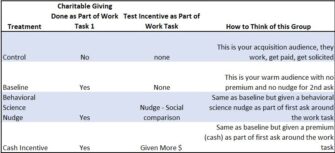Does Giving Beget More Giving?
“Your best future donors are your best past donors.”
Circular logic if there ever was. Let’s dig in a bit deeper.
If you donated at 2pm today and got another solicitation at 1 minute past 2pm, would you give again? What about 2pm tomorrow? A week later, a month? Probably all of us have some subjective answer to this. Spillover refers to the behavioral impact of giving at Time A and it’s likelihood of giving again at Time B. There can be positive and negative spillover, increasing and decreasing the chances respectively. And the time component matters.
However, this isn’t a post about how often to solicit or the ‘pace’ of those solicitations, we’ve written about that extensively. In fact, so much that if we included every link, it would be it’s own mile long post. Here is one to start you on your way.
This is about how to solicit to minimize negative spillover.
There’s a rather large, natural field experiment playing out across every charity, every day arguing for negative spillover being a big problem. It’s called 2nd gift conversion. The vast majority of “donors” don’t give after the first donation.
There are certainly situational and external factors explaining some of the chasm between first and second gifts, and some of that is out of your control (e.g. financial change of circumstance, amotivated lightning in a bottle giving).
Negative spillover is the portion of the chasm that’s entirely under your control and starts with the psychological feelings you created with the first giving experience.
Was the initial solicitation guilt inducing? If so, your cup will spilleth over with negative spillover.
What about a behavioral science nudge versus a premium as a tactic in the first solicitation? Which one creates more negative spillover? To answer this we need an experiment that pits them head to head but we also need to know why. If we don’t know why something won we should assume the result is noise.
This experiment had a Part A with subparts and a Part B.
- Part A: Everyone performed an online task (answering quiz questions after reading a passage) and earned money for doing it.
- Treatment 1: Giving to charity as outcome of the online task
- Treatment 2: Given additional incentive on the quiz with either a behavioral science nudge or being given extra money for themselves
- Part B: Everyone was given a chance to make an online donation to a charity after the task
The conditions are below and it’s admittedly a complicated experiment so I’ve included my take on how to think about each condition and test group.

And the results.

Why does this happen? Knowing is key, that it happens isn’t enough. The reason is low quality motivation created by feeling an external pressure to give at Time 1 – i.e. the first donation for all groups (minus the control, which didn’t have a Time 1 giving option, only Time 2).
External pressure (e.g. guilt, feeling like one “has to”, avoiding feeling bad about oneself if I don’t give) creates low quality motivation and reduces the chance I’ll give a second time.
The nudge was deemed to be far less pressure inducing compared to the premium. This was determined by including survey measures as part of the experiment.
In fact, donations fell off by 63% if people felt a high degree of external pressure to give on the first donation. Do you think this might explain, at least in part, your 2nd gift conversion problem?
This can be addressed. We audit appeals (and write from scratch) to remove or greatly reduce pressurizing tactics and replace them with copy and design that provide the donor a greater sense of control, competence and relatedness. This moves you from low quality motivation to high quality and the opposite effect; people are more likely to give the next time.
Kevin


